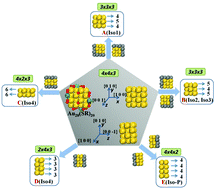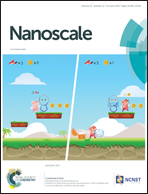A revisit to the structure of Au20(SCH2CH2Ph)16: a cubic nanocrystal-like gold kernel†
Abstract
Coinage metal clusters stabilized by organic ligands such as phosphine or organothiolate are well known to possess multi-twinned gold cores, and the face-centered-cubic (fcc) metal atom packing is unstable until the cluster size reaches a certain threshold. In this study, we searched for the smallest size gold nanocrystal protected by thiolate ligands by means of the crystal facet cleavage (CFC) method. Starting from the nanocrystal-like Au28(SR)20 cluster, after cleaving two different crystal facets and patching the ligand shells, we obtained five nanocrystal-like Au20(SR)16 isomers. These fcc-structured Au20 clusters were quite different from non-fcc Au20(SPh-tBu)16; the latter's total structure was determined by single X-ray diffraction. By employing dispersion correction density functional theory (DFT-D) calculations and considering ligand effects, we found that fcc-structured Au20(SR)16 isomers had comparable or even lower energies when compared with the non-fcc structure found in Au20(SPh-tBu)16. Furthermore, the calculation of optical absorption spectra based on predicted fcc isomers indicated that the cubic nanocrystal-like isomer structure is a good candidate to understand the structure of the Au20(SCH2CH2Ph)16 cluster.



 Please wait while we load your content...
Please wait while we load your content...